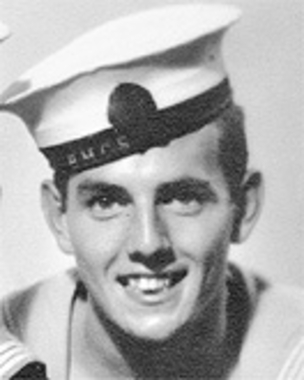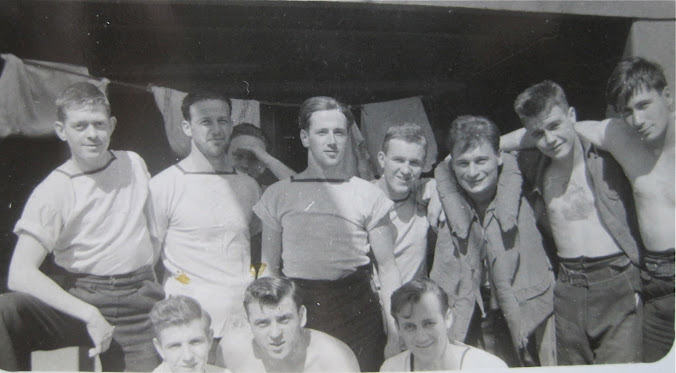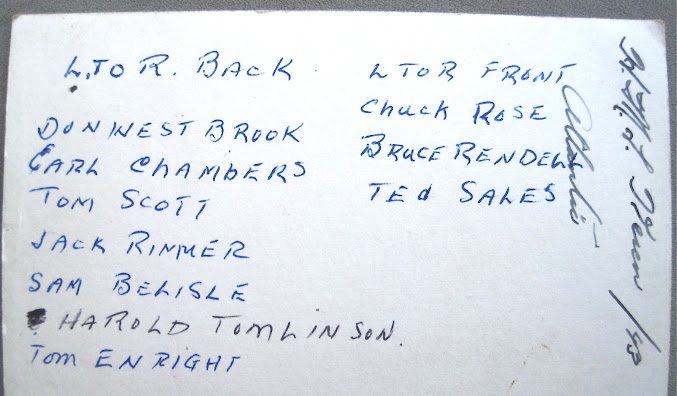The Reunions Head to Constance Bay, NE of Ottawa, ONT
Thank Goodness, Some Photographs List a Few Names
A statue dedicated to Canadian sailors, in Halifax, Nova Scotia
Introduction:
The veterans of RCNVR and Combined Operations likely gave support to Legion Branches and related associations for many years after the end of WWII. And as they grew older and driving here and there remained relatively easy (better cars and new highways, e.g., the 400 system, may have in fact made travelling easier), some veterans drove to one another's homes on occasion.
It is very possible that, for the sake of an informal navy reunion, my parents spiffed up my 1960s basement bedroom - in the 1980s, long after I'd departed my hometown for greener pastures, i.e., university, Teachers' College, student debt, marriage, full-time work... you know the drill.
Some of the following photographs list names of Navy/Combined Ops vets and locations where the men met... to remember the past and move on with their own lives, 40 - 50 years after the war had ended.
Some of the following photographs list names of Navy/Combined Ops vets and locations where the men met... to remember the past and move on with their own lives, 40 - 50 years after the war had ended.
Comments and questions can be addressed to G. Harrison at gordh7700@gmail.com
Readers can find a relevant audio file here: Audio: Nelson Langevin, RCNVR and Comb. Ops, N. Africa
My Navy buddy, Frank Herring, and I engaged in a Silent Pact overseas. When we were not required on board for duty we conspired to be the first ashore to get the pick. No Liberty Boat inspection for us - case the joint and slip ashore quickly and hopefully unseen.
The first picture seems to be flying solo; no names listed but I recognize a few sailors. The date in lower right corner is likely accurate or close to it:
L - R: Nelson Langevin, Gatineau, QUE. sits under the umbrella; my father,
Doug Harrison, Norwich, ONT (standing); unknown, (sitting); Art (Gash) Bailey
(white hat), London, ONT.; Frank Herring (story reference to follow)
I had the surprised pleasure of meeting Nelson Langevin at the Canadian War Museum during a brief stop there one summer (on the return leg of a motorcycle trip between London and Halifax). Nelson was serving as volunteer in the museum library and was late in arriving, so I was about to leave - after writing a note to him. He was dressed very neatly and was sporting a Combined Operations tie!
Nelson said, "I've been to your house in Norwich, sat under the
maple trees in your back yard." I appear stunned into silence : )
My father writes on the back of this photo: "Navy Buddies. Frank Herring (left), Doug Harrison." As well he adds, "At Constance Bay, ONT (NW of Ottawa), home of Norm Bowen."
July 31, 1992. The sailors are now in their early seventies.
Frank Herring and my father appear together in my father's memoirs as well.
Doug writes:
THE SILENT PACT AND ITS EPILOGUE*
My Navy buddy, Frank Herring, and I engaged in a Silent Pact overseas. When we were not required on board for duty we conspired to be the first ashore to get the pick. No Liberty Boat inspection for us - case the joint and slip ashore quickly and hopefully unseen.
Ashore very early at Southend-On-Sea, we went straight through the black-out doors into the Top-Hat pub. Oh Boy! Two WAAF Corporals, a beautiful blonde and lovely brunette. With two or three Johnnie Walkers tucked under our belts for courage, we asked if we could sit down with them. The answer was in the affirmative. I sat by the blonde and Frank by the brunette. Things are great, going according to plan. Time passes and all too soon it’s “Time Gentlemen Please” by the governor.
It was suggested by the girls that we go to a penny arcade down the street where there were pin ball machines and even one-armed bandits. Away we go. No pain. I grasp the arm of the blonde and Frank the brunette. There is a big pile up at the black-out doors. People going out and some coming in, trying to get a last beer. We finally manage to get out into the darkened street and when we arrive inside the lighted penny arcade Frank has the blonde and I have the brunette. Such is life.
The remainder of this story doesn’t sound so consistent with the Silent Pact. I suppose it is a Silent Tribute to all the WAAFs, I don’t know, but it’s all true. Events were to prove, in my own mind at least, that I did not lose in the shuffle in the black-out doors of the Top-Hat Pub at Southend.
"Dad, Well Done", page 53
* 'Its Epilogue' can be found on this site; please click on Story re Combined Ops, "Beautiful Friendship with Gracie"
It was suggested by the girls that we go to a penny arcade down the street where there were pin ball machines and even one-armed bandits. Away we go. No pain. I grasp the arm of the blonde and Frank the brunette. There is a big pile up at the black-out doors. People going out and some coming in, trying to get a last beer. We finally manage to get out into the darkened street and when we arrive inside the lighted penny arcade Frank has the blonde and I have the brunette. Such is life.
The remainder of this story doesn’t sound so consistent with the Silent Pact. I suppose it is a Silent Tribute to all the WAAFs, I don’t know, but it’s all true. Events were to prove, in my own mind at least, that I did not lose in the shuffle in the black-out doors of the Top-Hat Pub at Southend.
"Dad, Well Done", page 53
* 'Its Epilogue' can be found on this site; please click on Story re Combined Ops, "Beautiful Friendship with Gracie"
Frank Herring appears in the photo below, taken at HMS Saunders, Egypt, June 1943, as Canadians in Combined Ops prepared for the invasion of Sicily beginning on July 10.
Photo and caption from St. Nazaire to Singapore, two rare volumes
produced by Canadian Navy/Combined Ops veterans in the 1990s
Three reunion photographs follow that are of the same group. Names were listed on the back by my father but no location is given. I know my parents hosted an informal get-together - once at least - but they had a barn at the back of their property, not a vinyl-sided garage as seen here:
Back row, L - R: Joe Watson, Simcoe; Art (Gash) Bailey, London; Art
Bradfield, Simcoe; Jim Miller. Front L - R: Al Kirby, Woodstock;
Doug Harrison, Norwich; Norm Bowen, Constance Bay. 1990s
Norm Bowen, right side of the front row of retired sailors above, hosted a reunion at his home, as seen earlier. He and my father had a disagreement early in their navy careers (Norm was likely just following orders to get kit bags sorted - and get help, if needed - but my father did not want to help out... maybe because (according to Norm's D.O.B. on his obituary) Dad was three years older than Norm. Above, it looks like things have been patched up : )
Great photo of Norm Bowen as found in obituary, Ottawa Citizen
For more information about Norm's adventures re RCNVR and Combined Operations, please click on Audio re Combined Operations: Norm Bowen, SICILY
Another sailor my father rubbed shoulders with was Joe Watson of Simcoe, Ontario. They trained together in Hamilton in 1941 and travelled to the United Kingdom together in January, 1942 aboard a Dutch liner, the Volendam. They returned to Canada together in December, 1943 aboard the Aquitania, and shortly thereafter travelled together to the Combined Operations School at HMCS Givenchy III on Vancouver Island, where they served with scores of other Canadian sailors until war's end.
Enthusiasm reigns supreme! Maybe it was a long drive to get there.
Joe straightens a collar, Doug behind him (right). Aquitania, December 1943
L - R: Don Linder, Kitchener; Doug Harrison and Joe Watson;
Buryl McIntyre, Norwich; Chuck Rose (Rosie), Chippawa. Jan. 1944
Ready to board a train from Toronto, Ont. to Vancouver, B.C.
Seven sailors on the ferry from Vancouver to Nanaimo, B.C. Jan. 1944
Back L - R: Art Warrick, Hamilton; Ed Chambers; Don Westbrook (Westy).
Front L - R: Joe Watson, Don Linder, Doug Harrison, Unknown
While Joe Watson was travelling out west by train, or while he was settling into new barracks at Givenchy III near Comox on Vancouver Island, his hometown newspaper ran a story about his two years overseas (likely in January or February, 1944):
Doug Harrison served on the same landing craft as Joe Watson in Sicily and tells much of the same story related to the strafing by a German plane:
A signal came through, i.e., “Do not fire on low flying aircraft, they are ours and towing gliders.” What, in the dark? Next morning, as we slowly moved in, we saw gliders everywhere. I saw them sticking out of the water, crashed on land and in the vineyards. In my twenty-seven days there I did not see a glider intact. We started unloading supplies with our LCMs about a half mile off the beach and then the worst began - German bombers. We were bombed 36 times in the first 72 hours - at dusk, at night, at dawn and all day long, and they said we had complete command of the air.
Photo by RCNVR Officer David J. Lewis (D.J.L.)
Ephus P. Murphy’s pet monkey went mad and we put it in a bag of sand meant to douse incendiary bombs and threw him over the side. The Russian Stoker on our ship, named Katanna, said Dieppe was never like this and hid under a winch. Shrapnel and bombs just rained down.
war at Jig, How and George beaches near Noto and Avola
Once, with our LCM loaded with high octane gas and a Lorrie (truck), we were heading for the beach when we saw machine gun bullets stitching the water right towards us. Fortunately, an LST (landing ship tank) loaded with bofors (guns) opened up and scared off the planes, or we were gone if the bullets had hit the gas cans. I was hiding behind a truck tire, so was Joe Watson of Simcoe. What good would that have done?
Our beach had machine gun nests carved out of the ever-present limestone, with slots cut in them to cover our beaches. A few hand grenades tossed in during the night silenced them forever.
Slowly we took control and enemy raids were only sporadic, but usually at dawn or dusk when we couldn’t see them and they could see us. At such times we had to get out of our LCMs and lay smoke screens, and travelled the ocean side or beach side depending upon which way the wind was blowing. Even then they could see the masts sticking up. During one raid I was caught on the open deck of the Pio Pico, so I laid down - right on a boiling hot water pipe. I got up quickly.
A stick of Axis bombs lands near LCTs and LCMs near Avola, Sicily.
Photo credit - St. Nazaire to Singapore, Volume 1
"Dad, Well Done" pages 31 - 32
Based on the above episodes above, one can see why Canadian sailors would have much to talk about at navy reunions.
Two stories by John (aka Jack) E. Rimmer appear in St. Nazaire to Singapore: The Canadian Amphibious War 1941 - 1945, Volume 1 online at the University of Alberta. Go to pages 113 and 193. Tommy Scott is mentioned in the first story "at the 35th reunion in Thunder Bay in 1989". Chuck Rose and Ted Sale are mentioned in the second story. Happy hunting, I say.Based on the above episodes above, one can see why Canadian sailors would have much to talk about at navy reunions.
L - R: Nelson Langevin (lower left; Al Kirby, Art Bradfield, Doug Harrison
Busy as Bees: Nelson Langevin travelled around Africa aboard the Otranto with Chuck Levett of Comox; Al Kirby learned his landing craft was headed for Dieppe while crossing the English Channel w Canadian troops from Winnipeg on board (25-page account in Combined Operations); Art Bradfield served at Dieppe and wrote many poems about his 'Navy Days' (many found on this site); Doug penned his memoirs in 1975 and many stories in the 1990s for his hometown newspaper (most found on this site). Snoop around the website and if needed, write me for the links: gordh7700@gmail.com
Another reunion, another location 'unknown'. But my father listed names/date.
Back L - R: Art Bailey, Norm Bowen, Jack Rimmer, Doug Harrison, Sam Belisle,
and __ Martin. Front (bent legs) L - R: Nelson Langevin, Tom Scott. May, 1987
Three of the gents above show up in this next photo. Readers may recognize a couple of others oft-mentioned on this site as well, close friends of my father and mother, and frequent visitors to my childhood home in Norwich, Ontario in the 1950s and early '60s as I recall.
Canadians in Combined Operations aboard HMS Keren on their
passage around Africa on their way to Sicily, summer 1943.
Don W. and Chuck R. and their children are known to me.
L - R: Knubby (Limey) Percy Marian (a Brit?): Ed Corbett, E. Gallant
"Trip on Silver Walnut, 1943" writes my father on the back, same photo
The Navy Museum in Esquimalt B.C. is home to a navy hammock with Ed Corbett's and E. Gallant's name on it, along with the other members of the 80th Flotilla of Canadian Landing Crafts (including my father's and a few other familiar names on it). It had belonged to the afore-mentioned Stoker Katanna who gave it to S/Lt. David Rodgers when he came on board the Walnut minus his bedding. Rodgers returned the hammock during a Navy reunion in Australia (long after the war) and it was donated to the Canadian Navy Museum shortly thereafter.
A photo of SS Silver Walnut from my father's collection
Above two photos from Editor's collection. Taken at Esquimalt Museum
The next two photographs are included with my father's reunion collection, but I do not recall that he travelled to the Tower Hill Memorial, Trinity Gardens, London, England at any time in his life. Perhaps someone gave him copies. My mother went to London at one time in her life and her hand writing appears on the back of the first picture below:
Dad writes, "Merchant Navy Monument at Trinity Gardens. Copper plaques
in backgr. 24,000 names - Men, Ships. M. Navy and Fishermen Lost, WWII
Part of the copper plaques: My mother writes, "(Dedicated) To Merchant Seamen, To Men of the Fishing Fleet, War Graves Comm. Cemetery":
"I travelled with Warwick Castle (above) once or twice. She was sunk."
Doug Harrison wrote the above line on back of the photograph
I conclude this series with my own photo of 'the Sailor Statue' as found near the Maritime Museum of the Atlantic, in Halifax, Nova Scotia. The monument meant a great deal to my father.
I saw the statue for the first time when my father handed me a picture postcard of it, in the early- to mid-1980s. He said, "I want to be buried at sea." Those words immediately erupted into an energetic debate between him and my mother two seconds after they left his mouth - at their dining room table; I sat opposite them. Father wanted to be buried somewhere at sea, he didn't elaborate; Mother didn't want to be buried alone. "Husbands and wives are supposed to be buried together!"
During the hour-long drive back to my own home I determined that I agreed with both of them, but had no notion of how they both could "get their wish" at the time.
[Inscribed on base of installation: "The sailor statue representing those valiant young Canadians who served in both war and peace is symbolic of the thousands of sailors who were instrumental in the victory at sea and a fitting acknowledgement to those who continue to maintain the peace." The Atlantic Chief and Petty Officers' Association]
An idea very quickly sprang to mind many years later, the spring of 2003, between the time my father passed away (Feb. 03, 2003) and the date of the internment of his ashes beside his wife, my mother. Half his ashes were buried next to mother's grave; most of the remainder were buried at sea. But that's another long story.
At reunions the navy veterans surely recalled many tales we shall never hear. But as more are discovered they will find a home here.
If readers have photographs and stories of WWII veterans, especially those of Canadians in Combined Operations, please do not hesitate to contact G. Harrison at gordh7700@gmail.com or leave a comment in the section below. GH
Unattributed Photos GH
































No comments:
Post a Comment